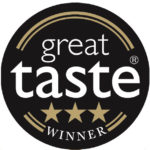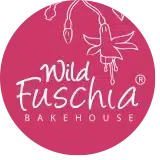€2.85
Out of stock


The Guild of Fine Food awarded Wild Fuschia Bakehouse Irish Soda Bread Mix 2 STARS in the 2020 Great Taste Awards. We are really delighted with this achievement.
The Irish Soda Bread Mix is easy to make and quick to bake and gives fantastic results for the novice baker and the more experienced baker alike. To make the soda bread only one additional ingredient is needed. I like to use the traditional buttermilk but ordinary milk will also work.
If you are on a vegan or dairy free diet you can substitute the buttermilk for any plant based alternatives such as rice milk, almond milk or soya milk. They will work equally well and produce a delicious loaf. This soda bread mix makes one loaf and the only equipment required is a baking tray for the oven.
This is a favourite for our customers because you can make so many different flavours, sweet and savoury. Why not try adding cheese or sun-dried tomatoes. Christmas is coming so why not make a sweet version and add in 2 dessert spoons of caster sugar, a handful of sultanas, zest of half a lemon and a teaspoon of mixed spice or cinnamon. This bread is delicious straight from the oven but my favourite way to eat is toasted and covered in lovely Irish butter and the house will be filled with the smell of Christmas. What could be better?!
One of those delicious discoveries is Irish soda bread: spread with butter and marmalade, it is perfect with a warm cup of tea. At dinner, it is especially good with fish. Soda bread is a perfect party snack or appetizer when paired with cheese or smoked salmon. If you’ve tried this distinctive bread, you might be curious about Irish soda bread history.
The bread wasn’t always a big part of the Irish diet. Before baking soda was developed, people had fewer options for making bread. Yeast was the best way to make the dough rise. However, the type of wheat grown in Ireland didn’t work well with yeast.
In addition, Irish people usually cooked over a fire, and not in an oven. (Notice how popular stews have always been in Ireland.) And for yeast bread to rise properly, it really needs to be baked in an oven.
Bread started to make part of the Irish diet with the arrival of baking soda. It gave people everywhere a new way to make bread. In 1791, a French scientist developed an early form of baking soda. Bread making suddenly became a lot easier as yeast wasn’t needed to make the dough rise.
Cooks everywhere began experimenting with new breads. They shared new recipes in newspapers and magazines in the UK, Ireland, and the USA.
Irish Soda Bread Mix
Ireland wasn’t the only soda bread country of origin, but Irish soda bread’s traditional history has its own unique story. The potato still reigned in Irish kitchens, however, for many years. It was an ideal crop for tenant farmers because it was easy to grow and very nutritious. Potatoes are also extremely versatile for cooking.
Everything changed in Ireland when the potato blight struck in the 1840s. The crop failure and subsequent behavior of landowners led to massive starvation, death, and emigration. Desperate for nourishment, Irish people focused on soda bread. It was quick and easy to make, and it could be cooked over a fire in the most basic country cottage. The ingredients were inexpensive. And the soda bread was also delicious.
Irish soda bread history wasn’t free of scandal. When the demand for bicarbonate of soda, a pure leavening agent, soared abruptly, it became scarce. This was a grim chapter in the story behind Irish soda bread.
The Great Hunger passed. Political unrest continued until the 1916 Uprising and Ireland’s eventual independence. Soda bread remained a staple throughout those turbulent decades.
From commercial bakeries to cozy cottages, people developed their own take on this rustic bread. Cooks got creative, using lighter flours and adding raisins. Grandmothers passed down recipes, and today groceries even carry gluten-free versions.
Some people will argue about what is and isn’t traditional Irish soda bread. But since people first started baking it, they added their own special touches. Some elements are consistent. It uses whole wheat flour, although it is often mixed with wheat flour.
Buttermilk is standard, although soured milk is an acceptable substitute. An egg is usually included. While bakers might bicker about even those basics, there can be no dispute about the need for baking soda!
Traditionally, it was made as a round loaf in a skillet-like pan over an open fire. The loaves always had an X cut into them. Here again, you’ll find a variety of opinions about why.

Most of my childhood memories evoke a mix of tastes and smells associated with baking with my Granny and Great Aunt Maisie; hovering beside the range as Maisie mixed the pancake batter and my big brother and I raced to see who could eat the most pancakes. I never won the race, but I always got my fill of those sugary, moreish delights, which smelt so good, so I never really lost.
My mother carried on the tradition and is affectionately known as Granny Bun, creating more memories for her Grandchildren. I feel I’m simply taking my place in a long line of women who loved to bake and to share that love with their nearest and dearest.
I’ve developed a range of award winning dry bread mixes that will help with meal times to make them easier, tastier and fresher. A busy schedule shouldn’t mean we have to compromise on the good things in life.
The bread mixes are easy to make, ready in under an hour and are simple, wholesome, tasty products that bring our recipes to your home, with great results.
Enjoy!
Sian McCann (Owner/Baker)